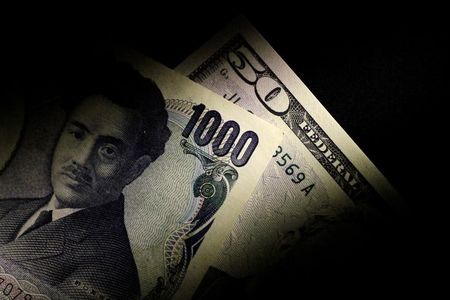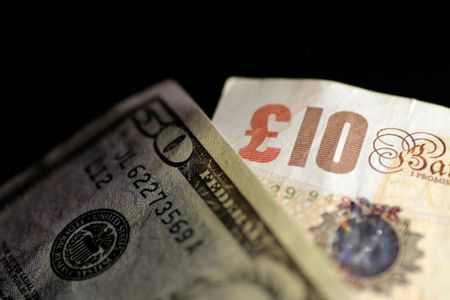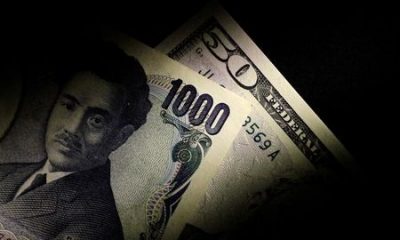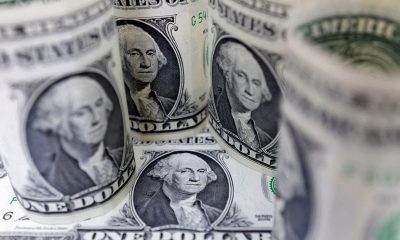Forex
Japan’s yen tumbles to 34-year low; US dollar gains after inflation data

By Gertrude Chavez-Dreyfuss
NEW YORK (Reuters) -The dollar surged to a fresh 34-year high against the yen on Friday, bolstered in part by U.S. inflation data that showed no signs of easing, coming in line with forecasts and affirming expectations that the Federal Reserve will likely delay cutting interest rates to later this year.
The dollar’s peak against the yen came after the Bank of Japan kept interest rates steady at its end of its two-day policy meeting, although it flagged future rate hikes. With the yen at multi-decade lows, market participants were on alert for possible intervention from Japan to prop up its currency.
The dollar hit 157.795 yen, the highest since June 1990, and was last up 1.3% at 157.71. The greenback briefly dropped as low as 154.97 earlier in the session, triggering speculation that the BOJ, which acts on the behalf of the Ministry of Finance, may have checked currency rates, supposedly a sign that the central bank is preparing to intervene.
It was not immediately clear what caused the move.
The greenback was on track for a 2% weekly gain against the Japanese currency, the largest since mid-January.
In the United States, the focus was on inflation.
The personal consumption expenditures (PCE) price index rose 0.3% in March, compared to a forecast of a 0.3% increase, data showed. In the 12 months through March, PCE inflation advanced 2.7% against expectations of 2.6%.
The PCE price index is one of the inflation measures tracked by the Fed for its 2% target. Monthly inflation readings of 0.2% over time are necessary to bring inflation back to target.
remove ads
.
“While the Friday result wasn’t quite as hot as the whisper number, the stark reality is that short-term trends on the Fed’s favored inflation gauge have steadily headed due north since the start of 2024,” wrote Douglas Porter, chief economist at BMO.
Porter added that the monthly rise of 0.32% prompted a small market sigh of relief, but noted that the figure would have matched the fastest monthly rise in the decade prior to the pandemic.
“That’s hardly going to give the Fed ‘confidence’ that inflation is calming,” Porter wrote.
Post-inflation data, U.S. rate futures have priced in a 58% chance of a Fed cut at the September meeting, down from 68% a week ago, according to the CME’s FedWatch tool. A Fed easing is priced more than 80% in December.
In afternoon trading, the was up 0.3% at 105.93.
The euro fell 0.2% to $1.0705. On the week, it was up 0.4%, on pace for its largest weekly rise since early March.
Versus the yen, the euro hit a new 16-year peak of 168.85 yen. It last traded at 168.845, up 1.1%.
On a weekly basis, the single European currency rose 2.5% against the yen, poised for its best showing since mid-June 2023.
Sterling slipped 0.1% to $1.2501. It rose 1.1% against the dollar on the week, its largest gain since early March.
In Japan, the BOJ left its short-term interest rate target at 0-0.1% on Friday and made small upward adjustments in its inflation forecast. Investors had not expected a policy shift but took the decision as confirmation that only small moves lie ahead.
remove ads
.
BOJ Governor Kazuo Ueda told a press conference after the rate decision that monetary policy did not directly targetcurrency rates, but exchange-rate volatility could have a significant impact on the economy and prices.
“If yen moves have an effect on the economy and prices that is hard to ignore, it could be a reason to adjust policy,” Ueda said.
Currency investors are now focused on next week’s Federal Open Market Committee (FOMC), in which the U.S. central bank is expected to hold interest rates steady.
The market is positioned for a hawkish Fed at the meeting and a stronger dollar given the run of better-than-expected economic data.
Brian Dangerfield, head of G10 FX strategy, U.S. at NatWest, wrote in a research note that the bank believes Fed Chair Jerome Powell will not rule out rate hikes, prerequisite for having a data-dependent policy. A rate hike, however, is not the FOMC’s base case, Dangerfield added.
Forex
More yen weakness likely – BOA Securities survey

Investing.com – More Japanese yen weakness looks likely, according to Bank of America Securities, citing its latest foreign exchange and rates sentiment survey.
At 10:25 ET (14:25 GMT), traded 0.2% higher at ¥155.83, with the pair having gained just under 2% this week as yen weakness returned.
Japanese authorities are seen having spent almost $60 billion the previous week pulling the yen away from a 34-year-low of ¥160.24 versus the dollar.
The bank’s survey has shown a consistently bullish yen bias since mid-2022, analysts at BOA Securities said, until now.
With USDJPY breaching new highs in April, investors have flipped to the largest JPY short since 2022, and there is a deep scepticism around the effectiveness of Japan’s FX intervention.
The bank said the majority of fund managers polled expect USDJPY to retest ¥160, with no one expecting a reversal to ¥150.
“While we generally share these views, the volte-face on JPY perhaps warrants near-term caution for shorts,” the bank added.
Forex
Dollar calm at end of week; sterling gains on growth data

Investing.com – The U.S. dollar steadied Friday after losing ground the previous session on weak jobs data, while the pound gained in the wake of stronger-than-expected growth numbers.
At 04:10 ET (08:10 GMT), the Dollar Index, which tracks the greenback against a basket of six other currencies, traded just higher at 105.115.
Dollar on track for small gains this week
The dollar steadied Friday, and is course for minor gains this week after losses on Thursday following the release of data showed a bigger-than-expected increase in weekly j.
This evidence of a cooling U.S. labor market reinforced some expectations that the will begin cutting interest rates by September.
However, sticky inflation remains a key point of contention for the Fed, with a slew of officials warning as much this week, comments which boosted the dollar this week.
There is “considerable” uncertainty about where U.S. inflation will head in coming months, San Francisco Federal Reserve President Mary Daly said on Thursday.
“In a scenario where inflation stays … level, just doesn’t make much further progress, then it’s not appropriate to start adjusting the rate unless we see the labor market faltering,” she added.
These comments put upcoming data, due next week, squarely in focus for more cues on interest rates.
Sterling benefits from strong growth data
In Europe, gained 0.1% to 1.2534, recovering from its lowest level since April 24 on Thursday, after data released earlier Friday showed that Britain’s economy grew by the most in nearly three years in the first quarter of 2024.
remove ads
.
U.K. expanded by 0.6% in the three months to March, the strongest growth since the fourth quarter of 2021, as the country’s economy exited the shallow recession it entered in the second half of last year.
On a monthly basis, the grew by 0.4% in March, faster than the 0.1% growth forecast.
The held interest rates at a 16-year high on Thursday, but two of the nine-person Monetary Policy Committee voted for a cut, suggesting that the central bank is moving towards such a reduction.
traded largely unchanged at 1.0783, with a light data calendar providing little impetus.
The has all but promised a rate cut on June 6, but uncertainty exists over how many further cuts the central bank will agree to this year.
Pierre Wunsch, Belgium’s central bank governor, made the case for further moves earlier this week, arguing that staying tight for too long was now a bigger risk than easing too early.
Markets currently price in 70 basis points of rate hikes for this year.
USD/JPY drifts higher
In Asia, rose 0.2% to 155.70, trading well above lows of 152 it had hit earlier in May.
Traders now see the 160 level as the new line in the sand for Japanese government intervention.
rose 0.1% to 7.2249, with the yuan weakening following reports saying U.S. President Joe Biden was considering imposing fresh sanctions on certain Chinese industries, such as electric vehicles and batteries.
remove ads
.
While the economic impact of the tariffs was unclear, such measures could attract retaliation from China, further souring ties between the world’s two biggest economies.
Forex
Asia FX weak with US inflation in sight; China tariff fears dent yuan

Investing.com– Most Asian currencies moved little on Friday as the dollar steadied from overnight declines, with focus turning squarely towards key U.S. inflation data due next week, which is likely to provide more cues on interest rates.
The Chinese yuan declined, as did currencies with trade exposure to China after multiple reports said that the U.S. was preparing more trade tariffs on Beijing.
Regional currencies took little support from an overnight decline in the dollar, as more signs of a cooling labor market reinforced bets that the Federal Reserve will cut rates in September.
But the dollar steadied in Asian trade, pressuring regional currencies as uncertainty ahead of key U.S. inflation data next week kept traders largely biased towards the greenback.
Chinese yuan weakens, USDCNY up on tariff reports
The Chinese yuan’s pair rose 0.1% as multiple reports said U.S. President Joe Biden was considering imposing fresh sanctions on certain Chinese industries, such as electric vehicles and batteries.
While the economic impact of the tariffs was unclear, such measures could attract retaliation from China, further souring ties between the world’s two biggest economies.
Other currencies with trade exposure to China fell tracking this notion. The Australian dollar’s pair fell 0.2%, while the Singapore dollar’s and the South Korean won’s pairs lost 0.1% and 0.3%, respectively.
Japanese yen remains fragile, USDJPY nears 156
Weakness in the Japanese yen persisted this week, as the pair recouped a bulk of its losses made after the government seemingly intervened in currency markets last week.
remove ads
.
The USDJPY pair rose 0.2% to 155.73 yen, trading well above lows of 152 it had hit earlier in May. Traders now saw 160 yen as the new line in the sand for Japanese government intervention.
Household spending data for March, released earlier on Friday, showed some resilience- a trend that could potentially underpin Japanese inflation expectations.
Dollar steadies, set for weekly gains ahead of inflation data
The and rose slightly in Asian trade, recovering a measure of overnight losses. But the greenback was still trading up about 0.2% for the week.
The greenback fell on Thursday after data showed a bigger-than-expected increase in weekly , furthering expectations of a cooling U.S. labor market.
This reinforced some expectations that the Fed will begin cutting interest rates by September.
But sticky inflation remained a key point of contention for the Fed, with a slew of officials warning as much this week.
Their comments put upcoming data, due next week, squarely in focus for more cues on interest rates.

 Forex2 years ago
Forex2 years agoForex Today: the dollar is gaining strength amid gloomy sentiment at the start of the Fed’s week

 Forex2 years ago
Forex2 years agoHow is the Australian dollar doing today?

 Forex1 year ago
Forex1 year agoUnbiased review of Pocket Option broker

 Forex2 years ago
Forex2 years agoDollar to pound sterling exchange rate today: Pound plummeted to its lowest since 1985

 Cryptocurrency2 years ago
Cryptocurrency2 years agoWhat happened in the crypto market – current events today

 World2 years ago
World2 years agoWhy are modern video games an art form?

 Stock Markets2 years ago
Stock Markets2 years agoMorgan Stanley: bear market rally to continue

 Economy2 years ago
Economy2 years agoCrude oil tankers double in price due to EU anti-Russian sanctions

































